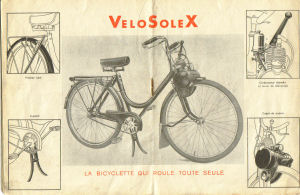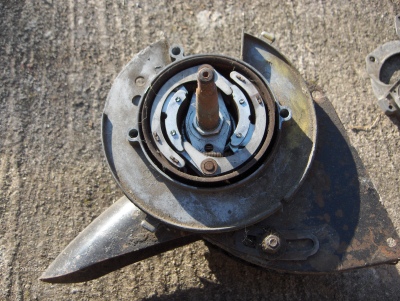The history of Solex
Solex with roller transmission
The first prototype of Velosolex was completed in 1941.
It has a motor of 38 cm³ on a part cycle of man bike with closed frame. The color is already black with gold threads.
The version that was chosen for the pre-series, and which will be kept for the first models, has a different cycle part. It is open, made of a single tube gooseneck. After a few years of testing and development, the brand launched its first model in 1946. The engine displacement is increased to 45 cm³ to deliver a power of 0.4 hp at 2000 rpm.
In the following years, some improvements will be made to the cycle part, the most important of which date from 1951with the addition of a center stand and an engine lift lever fixed on the cylinder head.

From 1954, the models are defined by numbers, such as the Solex 330 which differs from its predecessor by a sheet metal rack and a motor with a displacement of 49 cm³. The power is now 0.5 HP.
The Solex 660 was released in 1956. It is equipped with a brand new frame with footrest and the design of the engine part changes slightly: the tank and the magnetic flywheel are now ribbed and the headlight integrated into the engine cowling.
In 1957 the Solex 1010 arrives on the market. The frame is identical to that of the 660 but the engine has been reworked: new piston-cylinder assembly, enlargement of the air filter and exhaust in S.
The 1010 is equipped in 1959 with a wheel of 550 and will take the designation Solex 1400.
The new 1 ¾ x 19 tire size will remain standard until the last 3800.
 | In 1960, the automatic centrifugal clutch, see photo opposite, is introduced on the model Solex 1700. At standstill, the engine is engaged on the roller, which allows its start by pushing the solex. The centrifugal force exerted on two weights by the rotation of the motor in operation governs the torque transmission. The cooling of the engine required during stops made possible is achieved by air pushed by means of fins positioned on the magnetic flywheel. The capacity of the tank is increased to 1.4 liters. |
The Solex S2200 is produced from 1961. It has a suppression system and sees its engine power increased from 0.5 to 0.7 HP.
The Solex S3300 has the 3rd frame model, now rectangular and sheet folded and welded. It was introduced to the public in 1964. The front and rear fenders are those of an S 2200.
The 1966Solex S3800 is an S 3300 with a motor giving a little more torque. The fenders are ribbed on each side and the air filter has a S 3800 label written in white on a red background.
Pour la première fois dans l´histoire du Solex, ce modèle est disponible dans une robe bleue et rouge pour les S3800 « luxe », et en blanc pour les S3800 « super luxe ». Les pneus sont à flancs blancs.
The S 3800 will be produced until 1988 and undergo upgrades such as the addition of an accelerator, straight handles and reflex reflectors.
In 1971, Solex released the 5000 in parallel with the S 3800. It is a version equipped with small 16-inch wheels, stainless steel fenders and a raised handlebars. It is available in blue, yellow, orange and white. The tank and the magnetic flying cover are on all white plastic versions.
The 5000 also exists in foldable version, the Plisolex. It has a hinge on the central beam of the frame that allows folding and a motor quickly removable.
Solex with cardan transmission
The Flash arrives in 1968. Finished the transmission by roller! This original machine is equipped with a cardan transmission and a rear disc brake. There will be 3 versions: the first without suspension with front brake pads, then one with a front wheel suspension with a drum brake, and finally the Flash will take the name of 6000 being equipped with a telescopic fork.
Solex with chain transmission
The Tenor range was launched in 1973 and is available in different finishes
- R without rear suspension.
- L standard available in blue, yellow and orange.
- S only delivered in yellow and equipped with handlebars, turn signals and a large saddle.
- a manual gearbox model, the S4, is also available.
They are equipped with Franco Morini engines that will be replaced with the exception of the S4 by Anker-Laura engines. The models will take the GL and GS designation.
In 1974, Motobécane took over the management of Solex and stopped the marketing of the various Solex models except for the S 3800.
In 1947, BP creates SOLEXINE. This gasoline-oil mixture has been specially designed for vehicles of the brand Velosolex.


